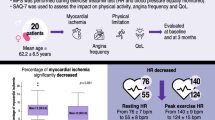Summary
The clinical efficacy of a new slow release preparation of the calcium antagonist gallopamil was assessed in 20 patients by diary cards and treadmill exercise tests. A single blind phase of two week periods of placebo, gallopamil 100 mg o.d. and gallopamil 100 mg b.i.d., blinded to the patient, was followed in 18 patients by a double blind comparison of gallopamil 100 mg od versus 100 mg b.i.d.
Angina frequency and trinitrin consumption per week were both significantly less on high dose (2.7 and 1.7) than on low dose (5.4 and 3.4) respectively. Treadmill total exercise time was longer on high dose (523 s) than low dose (449 s). Other exercise test parameters showed similar improvements on high dose treatment.
Gallopamil was well tolerated. PR interval correlated best with plasma gallopamil level, while exercise test parameters correlated best with the log plasma level of its major metabolite nor-gallopamil.
Similar content being viewed by others
References
Fleckenstein A, Fleckenstein B, Spah F, Byon YK (1984) Gallopamil (D-600) — a calcium antagonist of high potency and specificity. Effects on the myocardium and pacemakers. In: Kaltenbach M, Hopf R (eds) Gallopamil. Pharmacological and clinical profile of a calcium antagonist. Springer, Berlin Heidelberg New York, pp 1–32
Donati C, Barbi G, Guffanti E, Vaccarella A, Meregalli M, Colnago R, Mazzola C (1985) Single blind evaluation of gallopamil, a new calcium antagonist agent, in stable exercise induced angina pectoris. Curr Ther Res 38: 566–571
Mangino SG, Scrutinio D, Lagiola R, Mastropasqua F, Caiati C, Sisto F, Alfano F, Chiddo A, Rizzon P (1986) Placebo-controlled study of gallopamil in the treatment of angina at rest. Curr Ther Res 40: 270–277
Tartagni F, Maiello L, Marchetti G, Dondi M, Franchi R, Monetti N, Magnani B (1989) Clinical and haemodynamic effects of long-term administration of Gallopamil in patients with coronary artery disease and normal or impaired left ventricular function. Am J Cardiol 63: 291–295
Rettig G, Sen S (1984) Acute and long-term effects of Gallopamil in patients with stable angina pectoris. In: Kaltenbach M, Hopf R (eds) Gallopamil. Pharmacological and clinical profile of a calcium antagonist. Springer, Berlin Heidelberg New York Tokyo, pp 136–142
Stieren B, Buhler V, Hege HG, Hollmann M, Neuss H, Schlepper M, Weymann J (1984) Pharmacokinetics and metabolism of Gallopamil. In: Kaltenbach M, Hopf R (eds) Gallopamil. Pharmacological and clinical profile of a calcium antagonist. Springer, Berlin Heidelberg New York, pp 88–93
Sucic M, Schiemann J (1984) Results of an open multicentre study with 455 patients with coronary heart disease, treated with Gallopamil for 1 year. In: Kaltenbach M, Hopf R (eds) Gallopamil. Pharmacological and clinical profile of a calcium antagonist. Springer, Berlin Heidelberg New York, pp 132–135
Author information
Authors and Affiliations
Rights and permissions
About this article
Cite this article
Markus, H.S., Chong, E.M.F. & Wilcox, R.G. Gallopamil slow release: a double blind study of twice daily versus once daily treatment in chronic stable angina. Eur J Clin Pharmacol 42, 271–273 (1992). https://doi.org/10.1007/BF00266347
Received:
Accepted:
Issue Date:
DOI: https://doi.org/10.1007/BF00266347




